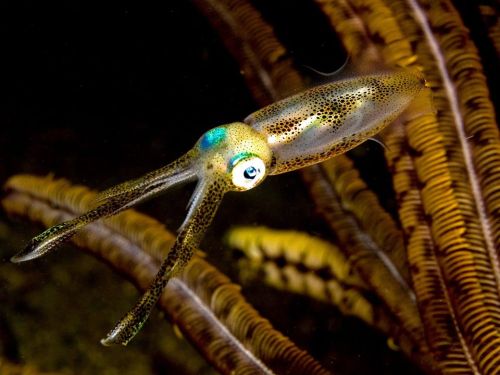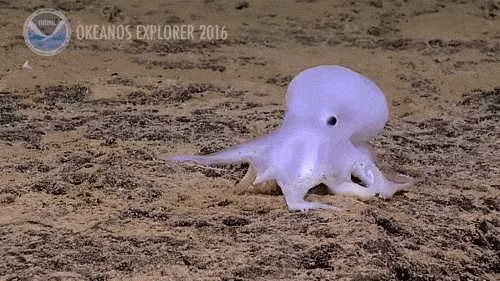Inked!

Inked!
Squid (and their relatives of class Cephalopoda) have long been known to release ink when threatened by a predator. The ink acts as a smokescreen - obscuring the senses of the predator allowing the squid valuable seconds to escape their notice. Until now, this was thought to be the ink’s only function. However, scientists have discovered that at least one tiny species of squid - the Japanese pygmy squid (Idiosepius paradoxus) - utilises ink for an entirely different reason - they use it to hunt.
Keep reading
More Posts from Llamaslikesciencetoo and Others
Astronaut Scott Kelly to Retire from NASA in April
NASA logo. March 13, 2016 NASA astronaut and one-year crew member Scott Kelly will retire from the agency, effective April 1. Kelly joined the astronaut corps in 1996 and currently holds the American record for most time spent in space. After retiring, Kelly will continue to participate in the ongoing research related to his one-year mission. He will provide periodic medical samples and support other testing in much the same way that his twin brother, former astronaut Mark Kelly, made himself available for NASA’s Twins Study during his brother’s mission. “This year-in-space mission was a profound challenge for all involved, and it gave me a unique perspective and a lot of time to reflect on what my next step should be on our continued journey to help further our capabilities in space and on Earth,” Kelly said. “My career with the Navy and NASA gave me an incredible chance to showcase public service to which I am dedicated, and what we can accomplish on the big challenges of our day. I am humbled and excited by new opportunities for me to support and share the amazing work NASA is doing to help us travel farther into the solar system and work with the next generation of science and technology leaders.”
Image above: NASA astronaut Scott Kelly inside the cupola of the International Space Station, a special module that provides a 360-degree viewing of the Earth and the station. Image Credit: NASA. Kelly flew in space four times, beginning with space shuttle Discovery’s trip to NASA’s Hubble Space Telescope on the STS-103 servicing mission in 1999. On his second mission, STS-118, he crossed the threshold of the International Space Station for the first time as commander of space shuttle Endeavour. He returned to the station for a six-month stay in 2010, commanding Expedition 26. A veteran of spaceflight, Kelly accepted the opportunity to participate in NASA’s unprecedented yearlong space station mission, which aimed to expand the boundaries of space exploration beyond low-Earth orbit through the collection of critical data on how the human body responds to extended space missions. On this mission, Kelly eclipsed two American space records. “Records are meant to be broken,” Kelly said. “I am looking forward to when these records in space are surpassed.” Kelly broke the American record for most cumulative time in space during his one-year mission, accruing 520 days. “Scott’s contributions to NASA are too many to name,” said Brian Kelly, director of Flight Operations at NASA’s Johnson Space Center in Houston. “In his year aboard the space station, he took part in experiments that will have far-reaching effects, helping us pave the way to putting humans on Mars and benefiting life on Earth. His passion for this work has helped give hundreds of thousands of people a better understanding of what NASA does, thanks in part to the numerous photos and updates he shared from space. We appreciate his years of service and anticipate many benefits to come from them, thanks to the research he’s supporting.” Related links: One-year crew: https://www.nasa.gov/content/one-year-crew Twins Study: https://www.nasa.gov/twins-study For Kelly’s biography, visit: http://www.jsc.nasa.gov/Bios/htmlbios/kellysj.pdf Image (mentioned), Text, Credits: NASA/Tabatha Thompson/Johnson Space Center/Brandi Dean/Karen Northon. Greetings, Orbiter.ch Full article

laser-free diet.


The Mud Dragons of Calvert Island, BC
Shedding light on these mysterious marine creatures.
by Josh Silberg
Spiky headed dragons roam the ocean floor from the poles to the tropics. But these are not winged beasts from the pages of science fiction. These strange creatures are Kinorynchs, aka “mud dragons“, and they are very real.
Roughly the size of a grain of salt, mud dragons are often overlooked, but a team from the Hakai Institute and the University of British Columbia (UBC) hopes to give them the spotlight they deserve.
“Canada has very few reports on these animals. The first step is to know what is there,” says Dr. Maria Herranz, a Hakai post-doctoral scholar and resident mud dragon expert at UBC…
(read more and see video: Hakai)
images by Marria Harranz

Untitled by twyscape

Satomi’s pygmy seahorse (Hippocampus satomiae) is the smallest known seahorse in the world with an average length of 13.8 millimeters. (via)

Bawean warty pig may be world’s rarest pig, with only 230 around
by Fred Pearce
By day, they rest in the surviving scraps of rainforest on their remote tropical-island home. By night, they grub around for tubers and roots in the forest gardens of local communities, dodging guard dogs and the occasional angry farmer with a gun.
Now, the diminutive warty pigs of Bawean, a small island in Indonesia’s Java Sea, have a new claim to fame: they may be the rarest pigs in the world.
The warty pigs of Southeast Asia come in many shapes and sizes – and, it seems, many species too. Often dismissed as little more than pests, they are receiving a taxonomic makeover, with a dozen distinct species now acknowledged, and others likely to emerge.
The latest is the Bawean warty pig (Sus blouchi), a dwarf relative of the Javan warty pig (Sus verrucosus), but now claimed to be a species in its own right…
(read more: New Scientist)
photograph via: Bawean Endemik Konservasi Initiatif



Meet the orchid mantis.
Orchid mantises—particularly juveniles—seem aptly named. They’re predominantly white with pink or yellow accents, similar to some orchids and other flowers, and their four hind legs are lobed, like petals. But if you search for an exact floral counterpart, as behavioral ecologist James O’Hanlon did, you probably won’t find one. “I spent forever looking for a flower that they look just like,” he says, to no avail.
As it turns out, rather than mimicking one floral species, the insect instead may embody a “generic or an average type of flower” in order to attract bees and other pollinating insects as prey.
What’s more, as far as O’Hanlon can tell, it’s the only animal on record that “takes on the guise of a whole flower blossom” as a predatory strategy.
Learn more here.


The Okeanos Explorer has discovered a very cute octopus at a depth of 4,290 metres.
This is the deepest an octopus of this particular sub order of octopus has ever been seen.
The National Oceanic and Atmospheric Administration noted this is a completely unsubscribed species and perhaps not belonging to any specific genus. Highlighting how little we still know about the creatures in the depths of our oceans.
(Ocean Explorer)
Killer whales are smart animals. This is what they do in their natural habitat:

Not this:

Do animals have sex for fun? This video attempts to answer a question all of us might have asked ourselves at some point!
-
 freehacksandroidios liked this · 8 years ago
freehacksandroidios liked this · 8 years ago -
 pink-mooon reblogged this · 8 years ago
pink-mooon reblogged this · 8 years ago -
 pink-mooon liked this · 8 years ago
pink-mooon liked this · 8 years ago -
 oldnewsisgoodnews reblogged this · 9 years ago
oldnewsisgoodnews reblogged this · 9 years ago -
 oldnewsisgoodnews liked this · 9 years ago
oldnewsisgoodnews liked this · 9 years ago -
 foxjevilwild liked this · 9 years ago
foxjevilwild liked this · 9 years ago -
 tinsnip reblogged this · 9 years ago
tinsnip reblogged this · 9 years ago -
 llamaslikesciencetoo reblogged this · 9 years ago
llamaslikesciencetoo reblogged this · 9 years ago -
 tinsnip liked this · 9 years ago
tinsnip liked this · 9 years ago -
 caprimulgus-europaeus reblogged this · 9 years ago
caprimulgus-europaeus reblogged this · 9 years ago -
 caprimulgus-europaeus liked this · 9 years ago
caprimulgus-europaeus liked this · 9 years ago -
 lwhittierart liked this · 9 years ago
lwhittierart liked this · 9 years ago -
 philige liked this · 9 years ago
philige liked this · 9 years ago -
 bradylee33 liked this · 9 years ago
bradylee33 liked this · 9 years ago -
 t-reqs reblogged this · 9 years ago
t-reqs reblogged this · 9 years ago -
 redshift-13 liked this · 9 years ago
redshift-13 liked this · 9 years ago -
 kingofmoss liked this · 9 years ago
kingofmoss liked this · 9 years ago -
 sierrasanator liked this · 9 years ago
sierrasanator liked this · 9 years ago -
 moreanimalia reblogged this · 9 years ago
moreanimalia reblogged this · 9 years ago -
 the-bitchy-phoenix liked this · 9 years ago
the-bitchy-phoenix liked this · 9 years ago -
 the-bitchy-phoenix reblogged this · 9 years ago
the-bitchy-phoenix reblogged this · 9 years ago -
 youobviouslyloveowls liked this · 9 years ago
youobviouslyloveowls liked this · 9 years ago -
 cabult reblogged this · 9 years ago
cabult reblogged this · 9 years ago -
 vet-and-wild reblogged this · 9 years ago
vet-and-wild reblogged this · 9 years ago -
 radekrogus liked this · 9 years ago
radekrogus liked this · 9 years ago -
 temporal-index liked this · 9 years ago
temporal-index liked this · 9 years ago -
 inrumford liked this · 9 years ago
inrumford liked this · 9 years ago -
 thecraftgremlin liked this · 9 years ago
thecraftgremlin liked this · 9 years ago -
 albatoonoe reblogged this · 9 years ago
albatoonoe reblogged this · 9 years ago -
 cabult liked this · 9 years ago
cabult liked this · 9 years ago -
 drhoz liked this · 9 years ago
drhoz liked this · 9 years ago -
 primordialshrieking liked this · 9 years ago
primordialshrieking liked this · 9 years ago -
 kamidio liked this · 9 years ago
kamidio liked this · 9 years ago -
 speciesofleastconcern reblogged this · 9 years ago
speciesofleastconcern reblogged this · 9 years ago -
 speciesofleastconcern liked this · 9 years ago
speciesofleastconcern liked this · 9 years ago -
 pagurus reblogged this · 9 years ago
pagurus reblogged this · 9 years ago -
 francoisbry liked this · 9 years ago
francoisbry liked this · 9 years ago -
 greenreblooming liked this · 9 years ago
greenreblooming liked this · 9 years ago -
 llamafollower liked this · 9 years ago
llamafollower liked this · 9 years ago -
 princejelloctopus liked this · 9 years ago
princejelloctopus liked this · 9 years ago
Mainly interested in ecology, but also the entirety of science.
179 posts